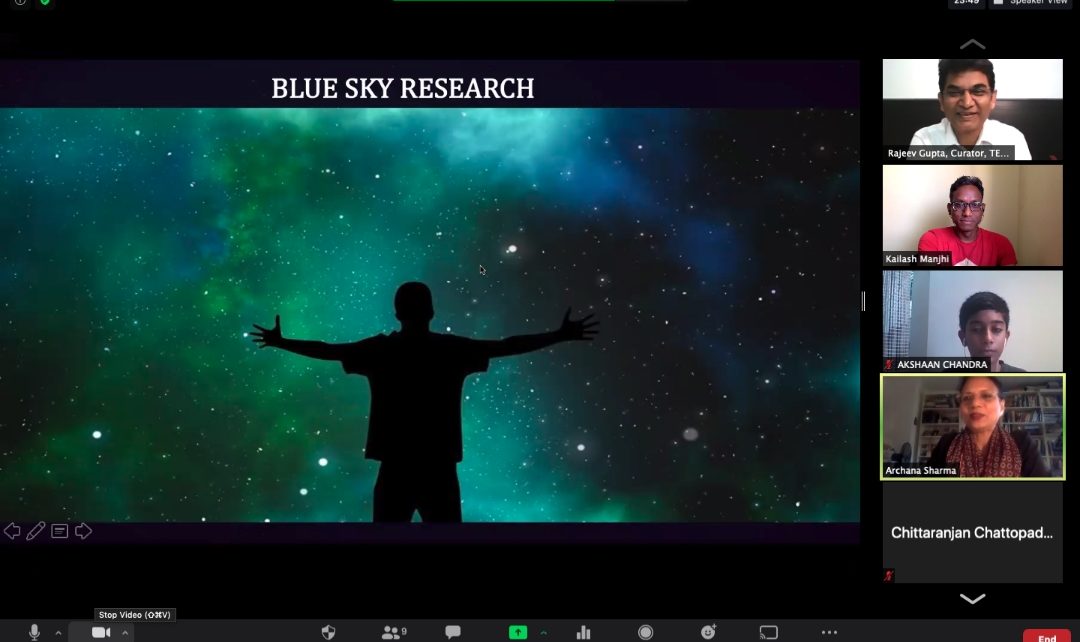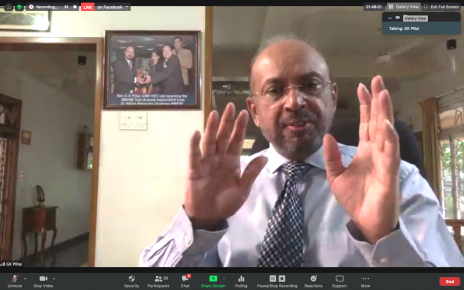Ranchi, Jharkhand | July | 27, 2020 ::
TEDxKanke organized a Webinar with the title Blue sky research in midst of covid 19
Speaker was Archana Sharma, Nuclear Scientist, CERN Geneva and Moderated By: Mr Rajeev Gupta, Curator, TEDxKanke
• Nuclear Physics is still more “unclear” than “nuclear”. There is still a lot more to be learned.
• Blue Sky Research is research which ask questions about nature and universe, driven by unanswered curiosity. There are doors opening to new knowledge and blue sky sits on the front lines of these doors, looking for answers and further questions.
• One of the first questions was Newton asking why the apple fell on the earth. Asking this led to discovery of gravity and how matters interact. Asking questions led us to understand how solar system works and galaxies move.
• Splitting matters by colliding them leads us to see the smaller pieces and particles that matter is made of. A big understanding of indivisible particles has emerged over time and through experiments like using cosmic ray interaction with matters. A standard module of particle physics has been created that places the fundamental particles in a series.
• Tim Burners Lee was 23 years old when he came to CERN. He suggested a project on creating a protocol – http – and how to connect data between two computers. This led to data sharing around the world and web was born. It emerged without a patent and was given free to the world for free. The impact of this thought has been tremendous with trillions of dollars depending on internet today.
• The humble electron was born which changed microscopy. The scanning electron microscopy was developed with time and was a major reason why we could discover and observe the coronavirus through extremely high resolution.
• Asking questions, indeed, have led to life changing discoveries. This is where Blue Sky research comes into picture.
On the Large Hedron Collider
• All research suggests that we can only see a small fraction of universe. About 95% of universe exist as dark matter or dark energy. Gravitational waves and black holes have been established as well.
• We want to smash protons at very high energy for recreating The Big Bang in laboratory conditions in a closed environment. The collision was meant to understand what is produced in such an experiment.
• We have a huge microscope, which is ultra-high energy accelerator which called the Large Hedron Collider. There are two beam pipes that go 27 km in circumference and the protons are circulated in these pipes. The protons move in bunches at high speed so that when they collide, masses of other particles can come out.
• We study the results through CMS where we take pictures of collision that happens. Numerous pictures are taken for statistical reasons and fed into data servers and computers to obtain conclusions.
• The protons inside the LHC that collide can lead us to identify the missing pieces in the structure of the standard module of particles. We did expect to create the Higgs – a very heavy particle that has been responsible along with the Boson that has been responsible to give mass to other particles.
• If we were able to find the signature of dark matter, we would be able to explain the dark energy or dark matter. And this Blue-Sky research is what we are after.
• We were able to discover and identify, proving the existence of the Higgs-Boson particles in April 2012.
On other opportunities
• The magnets and the acceleration mechanism that are used (in the largest accelerator on the planet) can help us to produce beams of particles that be used for therapy such as cancer therapy.
• The target illumination of cancer cells without damaging the healthy cells by creating a digital scalpel through the beams has been a huge progress in the treatment of cancer patients.
• In addition, in COVID times, creativity and productivity of ideas has increased. In CERN, a new high energy ventilator has been proposed to help covid patients recover faster.
Audience Questions:
What actually happens to the particles when banged together at a massive amount of force?
By Akshaan Chandra, DPS Ranchi Class VII Student
• The lego helicopter analogy can helps us see that the energy and mass have to be balanced. The energy in the helicopter is converted into mass and now the equation have to balances when the mass is disintegrated – which dissipates into energy.
What kind of interest in CERN research is there in the Indian ancient knowledge? How do you see the interest of exploration developing in our education system? What kind of association are Indian scientists undertaking at the CERN?
By Dr Shreeranjan, Retd. IAS
• We as Indians are very proud of our ancient culture. However, science is based on facts. At CERN we are doing big experiments but are purely based on facts.
• Massive consolidation of infrastructure is required in the country. Navoday schools for example have one of the best students yet struggles with adequate facilities. We require a centralized system which provides a level playing field to all the students. Exposure and interaction are essential for the development of interest and exploration in our students.
• It is a colossal problem to address and has to happen bit by bit where access of knowledge to children improves and we reach the ideal stage where everyone has access to the same curriculum.
• India has been present at the CERN from 60s and 70s. It used to be mostly Tata Institute of Fundamental Research. The crème de la crème of expertise was lying there. Slowly other institutes joined and by now there are about 40-50 institutions that are participating mad making impact at the CERN.
Now that we are done with Higgs, the next big question is super symmetry. Do you see any new super particle or any sniff of such a thing in the air?
By Rohit Tripathy, Founder, Ranchi Mall
• As far as I know, a lot of work in this direction is going on. Groups are looking for exotic particles n the data. For the moment, there is nothing but perhaps some signatures could be coming up after we start a new phase that will be completed next year.




